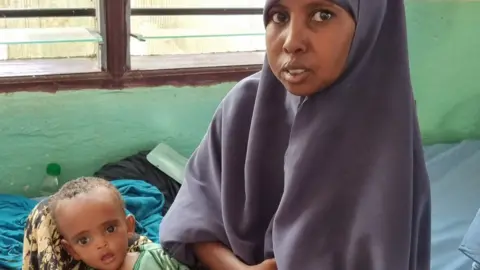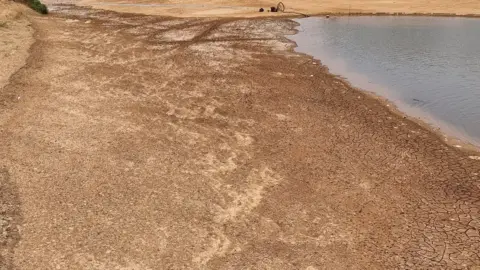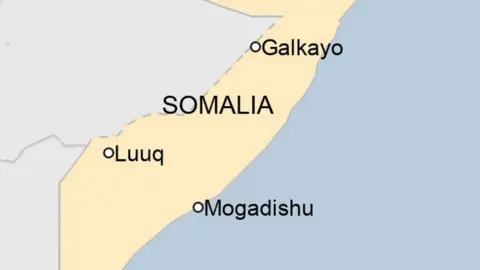Somalia drought: 'Act now or 350,000 children will die'
 BBC
BBCAs Somalia faces what experts call its worst drought in a decade, children are bearing the brunt. Parents are struggling to feed them, with nearly half of the country's under-five population likely to suffer from acute malnutrition by June.
Nimco Abdi gently places her six-month-old baby girl onto a plastic basin supported with sisal ropes. The weighing scale from which the basin hangs reads 0.6 stone (4kg). That is almost less than half of what the child's ideal weight should be.
She is too tiny for her age. Her eyes are sunken, bones are protruding and her skin is wrinkled and pale. She lets out a feeble, barely audible cry as Nimco picks her back up.
"I used to breastfeed her. But I became so sick from lack of food. And she got so thin, I decided to bring her here. At least she can get milk and drugs," says Nimco.
Nimco has just arrived at a malnutrition stabilisation centre in Luuq, 310 miles (500km) from Mogadishu in south-western Somalia. She is given a bed inside the facility, which she will have to share with another mother.
Her story is one among many mothers who are facing the potential death of their children by malnutrition.
"If nothing is done, it is projected that by the summer of this year, 350,000 of the 1.4 million severely malnourished children in the country, will perish," warns Adam Abdelmoula from the United Nations Office for the Coordination of Humanitarian Affairs (Ocha).
"Already in this country, 70% of school-age children are not attending school. In just one state in Juba land, the drought has led to closure of 40 schools and that is going to be the trend in many drought-affected areas," he continues, adding that some girls are being married off early because their families cannot feed them.
Villages deserted
Fatuma Mohamed, a nurse at Luuq's malnutrition centre, says the bed capacity is 18, but more than 50 children and their mothers are here.
"Our worry is the big numbers that we are getting. We are overloaded and operating beyond our full capacity. We have been running short of medical supplies," she says.
Some of the children are so feeble, they die on the way.
"The women are coming with severely malnourished children. And most of them also have acute watery diarrhoea and measles," she continues.
This centre is only a glimpse of the situation across Somalia. The drought has affected 4.5 million people. The Juba River, the largest in Somalia, has barely any water left.

According to the UN, almost 700,000 people have been forced from their homes in search of food and water for them and their animals, and the numbers keep rising.
There have been four seasons of failed rains and temperatures are unbearably high - 90% of the country is dry.
Along the roads in rural areas, carcasses of animals are strewn all over - dead goats, donkeys and camels. This is catastrophic for the many Somalis who earn their living by raising and selling animals.
The prices for food and water are surging. Villages have been deserted as people move nearer to the urban centres in search of relief.
Those who remain behind are the elderly, who wait - either for the rain to fall, or for their young ones to come back with water.
The drought is affecting not only Somalia, but the rest of the Horn of Africa and many other parts of the continent. The International Committee for the Red Cross (ICRC) says at least a quarter of all Africans are facing a food security crisis.
There is also a dramatic rise in the numbers of displaced people. The hunger crisis is also being overshadowed by the Russia-Ukraine war, as all efforts, aid and funding are focused there.
The camps for internally displaced persons are scattered all over the country. And new ones keep springing up. Some people had not even recovered from the 2017 drought, which was declared a national disaster, before this one struck.
The worst is yet to come
In a camp in Galkayo, hundreds of miles north of Luuq, seven-month pregnant Hawa Fargod sits with her two small children. Her makeshift hut, like hundreds of others here, is made from sticks and covered with gunny bags and clothes. Her fireplace has been cold for days.
Next door to Hawa Fargod, Hawa Sharif narrates her three-day journey to the camp on a donkey cart, with her five children. The donkey died immediately when they got to the camp.
"That donkey was the last surviving animal we had. Everything else died."

The drought has forced families apart - the men have gone to the towns to earn a living, while the women and children move where they can get aid.
Humanitarian agencies say there is a huge funding crisis. They have just 3% of what is needed to intervene in the country.
They are trying to send water trucks, food supplies and medical aid. But this cannot reach everyone - and in the next few weeks, it will not be possible unless more funding and donations are made available.
With April rainfall forecast to be average or below average, there are fears that the worst is yet to come.
The feeling of an impending sense of doom is one Hawa Fargod knows all too well. Struggling with kidney disease herself as well as sick children, she is not hopeful for the future.
"I fear for my children," she says ominously.
